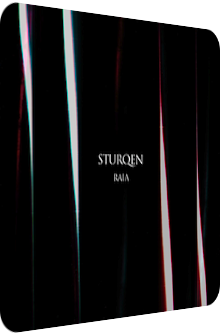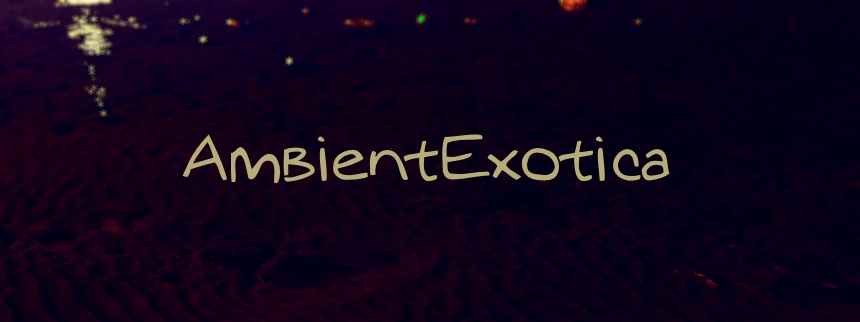
Sturqen
Raia
2012
If David Arantes and César Rodrigues aka Sturqen from Portugal had not come up with their self-released ten-track album Raia in April 2012, chances are quite high that I would have never reviewed their powerful, almost bone-crushing soundscapes full of energetic saw tooth waves, neon-colored plinking ignis fatuus blebs and threnodic crevasses in-between the pitch-black nothingness, for the highly experimental interplay in their vignettes does only cross the Ambient boundaries occasionally. Their latest album, however, does firmly reside in the Glitch-focused mellower realms, although that subgenre called Glitch is not the best term to aptly describe the scope of Raia. Momentarily, this classification has to do it… in tandem with the minimal album artwork which points to the very soundscape that I have just tried to outline. This is neither a hazy Drone album, nor are there complex, let alone catchy melodies to be found. Each of the ten tracks is a collage of dedicated electr(on)ic sounds that teach the listener – and even more so the reviewer – a bold lesson in finding the right words to nail down a certain aura, atmosphere and mood. Sturqen’s compositions do not seem to open up to the listener, the whirling maelstroms of lasers, snares and tone bursts are eternally bustling and only rely on themselves, not on a definite interpretation. The various antrums and vaults the duo creates consist of various layers of noises, carefully placed rhythmic patterns and at times even a drone layer or two, the latter of which are usually used in that genre to mediate between the harshness of the percussive structures and a balmier silkiness of analogue warmth as encapsulated in the drones. Not so in Raia where the drone layers are frosty, remote and shifty. The question remains whether there is anything even distantly mellifluous to be found on this release? For the connoisseur, there is indeed, as the rough template of Sturqen’s highly recognizable formula leaves tiny fissures through which traces of elegancy ooze.
The short and crisp In is the gateway into Sturqen’s definition of Ambient. Razorsharp high-frequency legato buzzes cut piercingly through a grey fog of wobbling static noise which camouflages the otherwise omnipresent blackness of the backdrop. Fans of horror video games or the Dark Ambient genre can relate to the unfolding diorama. The static noise is not plain and placid rather than lacunar, filled with spectral beings and stereo-panned tone bursts. These paths of uneasiness lead to Ummus, an exceptionally granular pink noise creek with bit-crushed bass spirals, critter-resembling percussive crystal shards of frost and an ethereal but banefully dusky synth placenta next to whirling wind gusts. The stabs of the acidic percussion layer hit the listener with full force, their overexposed brightness boosts their coldness and causes the other elements to seem murkier than they actually are. While Vcd surprises with a slow fade-in of equally unexpected blood-red tone sequences that inherit a certain grace – but are actually pernicious due to their rusty surface – in adjacency to the electric current sounds, sizzling thermal heat and cymbal whiplashes, Riulu does not take any hostages and unleashes a monotonous dark galaxy string with chirping cyberbirds, cascades of bits and bytes, frightening chimes and spiraling transfigured power saws. Despite the dark prospects, the chirping whistles are wondrously blithesome and at least to my ears provide a quirky but welcome counterpoint to the darkness. The following Monte depicts freezing temperatures due to its howling blizzardous sine waves, rhythmically tonality-changing Glitch pops and an infinitesimal cylon housefly trying to escape the life-threatening chilliness, becoming louder as the song progresses, then resembling the Oriental timbre of a synthetic shawm. I would call this a Dark Ambient track even though most of its ingredients are incredibly luminescent; their light remains cold and blue-tinted and never even encapsulates a scent of warmth.
Vela ventures back into a delicately mellow 16-bit cyberspace loaded with galactosamine laser beams and theremoconductive theremins whose decay and echoes are allowed to conflate with the softly bumping bass drones in the background. Even the admixed bumblebee string is curiously mild-mannered, and although the synodic hacksaw blades penetrate the peaceful aura with their brazen bile, I denominate Vela as Arantes’ and Rodrigues’ most accessible track on this album. The gentlemen should take this as a compliment, especially so in hindsight of the following Mare which presents a venomous virtual beachscape with wave-like machine infusions, bouncing two-step bass drops, monotonous sirens and aqueously reverberated clicks, all of them largely eerie devices that, in unison at least, make this a strangely mollifying place. The background may be black once again, but the entanglement of the sounds and the steady rhythm create a sense of motion and a positive repetitiveness, the latter being the nuts and bolts that keep the order intact and make this another gorgeous alcove-traversed Glitchscape. Up next is Canario, and what shall I say, the album gets better and better in its second phase as chippering laser pulses and bird-resembling tone eruptions mesh with a proper Drone setup: strong winds blow in close proximity, dark matter pads and elevator engines mesh and depart to make room for the final spacey segue comprising of blurred Pop songs coming out of a transistor radio and frog-evoking vesicles. The penultimate Musgo is the literal grower of the album, fading in slowly with its oxymoronic angel drone of doom and a gyrating three-beat rhythm. The drone swells and falls, oscillates and poises, the atmosphere is vault-like and cryptic, but undoubtedly somewhat languorous, at least in the given intrinsic context of Raia. The synth drones start to grow in the middle of the track, and it is here where it morphs into a horrendously terrorizing wild chase due to Sturqen adding aggressively stabbing staccato snares, hell, even a comparison to a machine gun cannot be ruled out entirely. The ensuing bileistic sound war leads to Kepler. This final piece spreads the Ambient realms and adjects flangered Gabba artifacts, scintillating coruscations and high-energy acid blebs over a heavily pumping beat which is later ennobled by electronic 80’s shakers. The drones, lasers and static noise slivers work tremendously well in tandem with the beat and the misty crystalline polyphony, making Kepler the centerpiece of the album, regardless of its placement at the end. Open-minded Ambient fans need to check this one out. Sturqen blast themselves out of their own album!
Raia is an incredibly dark release. Sure, this assertion is easy to make. There is just one problem: this overly short remark is not true. Raia glints, twinkles and gleams in multiple colors, but the created hue is crushing many souls due to its coldness and aggression. The lurking void of black nonentity is dangerously near; it is, however, successfully camouflaged by the ubiquitous flashes and bolts or occasionally by rivers of drones and static noise. There is only one tune, Vcd, which injects a potentially hummable melody into the reciprocating fundament, but otherwise, molecules, particles and flecks of all textures, surfaces, patterns and traits clash or unite with each other. The sound of Sturqen is remarkable, the duo created their own aesthetics-related voice. Is Raia an Ambient album? It is hard to answer that, but rest assured that in its entirety, it comes remarkably close at worst and enters the nexus of the genre at best. Whatever you make of this description, let me stress the phenomenon of Raia being a powerful work. There are quieter undertones inviting the listener to rest, but soon enough are vibrant shakers, grinding snares and far-out laser spirals intertwined with the drones. The mood is crestfallen, or no, let me rephrase that: there is no decisive mood, I cannot pinpoint it. Even the darker tracks do not scare the listener per se, but are strangely unattainable and inaccessible. The second half of Raia gets better in my opinion, but even after my third listening session, I could not find out whether this impression builds up due to a certain adaptation and familiarization to the soundscape taking place, or if the overall quality revs up independently. Regardless, Raia remains a beast, and can be closely tied to Centrozoon’s Boner (2012) or Jaap Blonk’s and Machinefabriek’s Deep Fried (2012) in regard to its noise level and convoluted arc. This one is definitely only for the hardened listeners who favor a concoction of textures and synths over fluffy drones and euphonious melodies.
Further reading and listening:
- Listen to the whole album on Sturqen’s Bandcamp page for Raia.
- Follow Sturqen at Twitter: @STURQEN.
Ambient Review 152: Sturqen – Raia (2012). Originally published on Nov. 28, 2012 at AmbientExotica.com.
